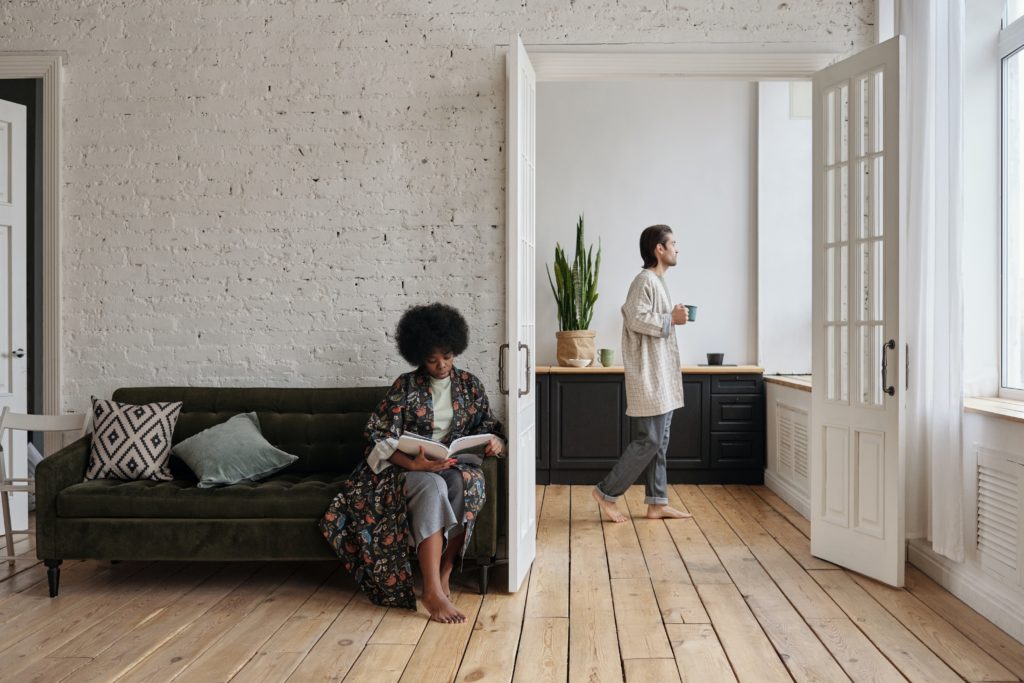NOVEMBER 2021

Hello!
In this issue:
- 7 Steps for Mortgage Prep
- 10 Mortgage Mistakes
- 5 Tips for Staging Your Home Yourself
- Economic Insights with Dr. Sherry Cooper
7 Steps for Mortgage Prep

Step 1 – Your Credit Score
Whether you qualify for a mortgage through a bank, credit union or other financial institution, you should be aiming for a credit score of 680 or greater for at least one borrower (or guarantor), especially if you are putting less than 20% down. If you are able to make a larger down payment of 20% or more, then a score of 680 is not required.
If your credit score does not meet the minimum requirements, there are a number of things you can do to improve it and your future financial success, including:
- Paying your bills in full and on time. If you cannot afford the full amount, try paying at least the minimum required.
- Pay off your debts (such as loans, credit cards, lines of credit, etc.) as quickly as possible.
- Stay within the limit on your credit cards and try to keep your balances as low as possible.
- Reduce the number of credit card or loan applications you submit.
- Considering an Alternative Lender (or B Lender) if you are struggling with credit issues.
I can help review your credit score and provide you with options for your mortgage needs.
Step 2 – Your Budget
When considering your budget, it is important to look at the purchase price budget, as well as your cash flow budget. Being house rich and cash poor makes for a no-fun home! The home price based on your cash flow budget may be dramatically different from the budget home price you qualify for. Not only does having a budget help you to understand your purchase price range and help you to find an affordable home, but it can also help you to see any gaps or opportunities for future savings. This will be instrumental when you become responsible for mortgage payments.
Step 3 – Your Down Payment
The ideal down payment for purchasing a home is 20%. However, we understand in today’s market that is not always possible. Therefore, it is important to note that any potential home buyer with less than a 20% down payment MUST purchase default insurance on the mortgage, and they must have a minimum down payment of 5%.
The down payment on your home could come from your own savings such as a savings account or RRSPs. Thanks to the federal government’s Home Buyers’ Plan, potential first-time home owners are able to leverage up to $35,000 of your RRSP savings ($70,000 for a couple) to help finance the down payment. A gift of a down payment from an immediate relative is also acceptable. If your down payment comes from TFSA or RRSP, the bank will want 90 days of statements to ensure the funds are accounted for. Gifted funds rarely require 90 days of proof.
Step 4 – Your Mortgage Options
Rate is only ONE of the many features in selecting the best mortgage product that meets your financial goals. With access to over 118 lending institutions, I am familiar with a variety of mortgage products to help you find the best mortgage for YOU! Plus, unlike banks, I am independent, licensed and focused on YOUR needs. This means that you can get the best rates and unbiased advice all for FREE while helping you advance major life goals.
Step 5 – Your Paperwork
When you apply for a mortgage, you will typically need to provide a standard package of documents, which almost always includes:
- Your valid government-issued personal identification
- One month of recent pay stubs from applicants who will be listed on the loan
- Letter of employment
- Your most recent two years’ worth of personal CRA tax filings and financials (if incorporated)
- Three months of bank account statements
- Proof of your down payment (minimum 5%)
- Documentation to explain any unusual (generally non-payroll) large deposits or withdrawals
Step 6 – Your Pre-Approval
To have the best success with your mortgage, it is recommended that you get pre-approved! This is done through me to ensure that you get the best mortgage product FOR YOU, from the best rate to the best term agreement. A Pre-approval helps verify your budget and allows your real estate agent to find the best home in your price range.
- Pre-approval guarantees the rate offered and locks it in for up to 120 days. This protects you from any increases in interest rates while you are shopping (phew!).
- Pre-approval lets the seller know that securing financing should not be an issue, which is beneficial in competitive markets!
Quick Tip: Don’t forget about the closing costs! These range from 1 to 4% of the purchase price and should be factored into your budget.
Step 7 – You’re Ready to Shop
You made it!! Once you have your down payment and have qualified for a pre-approved mortgage (your credit score is in order and all documentation has been provided), you are ready to start searching for your perfect home. If you’re stuck, I would be happy to give you recommendations for a realtor, if you don’t have one already.
Get in touch today and request a copy of my Homebuyers Guide!
10 Mortgage Mistakes

Whether it is your first house or you’re moving to a new neighbourhood, getting approved for a mortgage is exciting! However, even if you have been approved and are simply waiting to close, there are still some things to keep in mind to ensure your efforts are successful.
Many homeowners believe that if you have been approved for a mortgage, you are good to go. However, your lender or mortgage insurance provider will often run a final credit report before completion to ensure that nothing has changed. Changes in your credit usage and score could affect what you qualify for – or whether or not you get your mortgage at all.
To avoid having your mortgage approval status reversed or jeopardizing your financing, be sure to stay away from these 10 mortgage mistakes:
1. FALSIFY YOUR APPLICATION
Do not misrepresent your financials; you must be honest on your mortgage application. This is especially true when working together to secure your financing, as my main goal is to assist you in your home buying journey. Providing accurate information surrounding your income, properties owned, debts, assets and your financial past is critical. If you have been through a foreclosure, bankruptcy or consumer proposal, disclose this right away as well. I am here to help!
2. GETTING PRE-APPROVED
With all the changes and qualifying requirements surrounding mortgages, it is a mistake to assume that you will be approved. Many things can influence whether or not you qualify for financing such as unknown changes to your credit report, mortgage product updates or rate changes. Getting pre-approved is the first step to ensuring you are on the right track and securing that mortgage! Most banks consider a pre-approval to be valid for four months (120 days). So, even if you aren’t house-hunting tomorrow, getting pre-approved (and securing a rate-hold) NOW will come in handy if a new home is in your near future.
3. SHOPPING AROUND
One of the biggest mistakes people make when looking to secure a mortgage is not shopping around. It is easy to simply sign up with your existing bank, but you could be paying thousands more than you need to, without even knowing it! This is where I can help! With access to over 118 lenders and financial institutions, I can help you find a mortgage with the best rate and terms to suit YOUR needs.
4. NOT SAVING FOR A DOWN PAYMENT
Your down payment is a critical part of homeownership and a useful financial tool that you should utilize when purchasing a home. A down payment reduces the overall amount of financing you need and increases the amount of equity right from the start. Down payments also show the bank you are serious. In Canada, the minimum down payment is 5% (with mortgage insurance), with the recommended down payment being 20% if possible.
5. CHANGING EMPLOYERS OR JOBS
As employment is one of the most important factors that determines whether or not you qualify for financing, it is important not to change employers if you are in the middle of the approval process. Banks prefer to see a long tenure with your employer, as it indicates financial stability. It is best to wait for any major career changes until after your mortgage has been approved and you have the keys to your new home!
6. APPLYING OR CO-SIGNING FOR OTHER LOANS
Applying for additional loans or financing while you are currently in the midst of finalizing a mortgage contract can drastically affect what you qualify for – it can even jeopardize your credit rating! Save any big purchases, such as a new car, until after your mortgage has been finalized.
Also, just as applying for new loans can wreak havoc on a mortgage application, so can co-signing for other loans. Co-signing signifies that you can handle the full responsibility of the debt if the other individual defaults. As a result, this will show up on your credit report and can become a liability on your application, potentially lowering your borrowing power.
7. AVOIDING CREDIT MISSTEPS
As mortgage financing is contingent on your credit score and your current debt, it is important to keep these things healthy during the course of mortgage approval. Do not go over any limits on your cards or lines of credit, or miss any payment dates during the time your finances are being reviewed. This will affect whether or not the lender sees you as a responsible borrower.
Also, although you might think an application with less debt available to use would be something a bank would favor, credit scores actually increase the longer a card is open and in good standing. Having unused available credit and cards open for a long duration with a good history of repayment is a good thing! In fact, if you lower the level of your available credit (especially in the midst of an application) it could lower your credit score.
8. HAVING TOO MUCH DEBT
Credit card debt is on the rise and overuse of lines of credit can put you at risk for debt overload. Large purchases such as new truck or boat can push your total debt servicing ratio over the limit (how much you owe versus how much you make), making it impossible to receive financing. Some homeowners have so much consumer debt that they aren’t even able to refinance their home to consolidate that debt. Before you start considering a new home, make sure your current debt is under control.
9. LARGE DEPOSITS
Just as now is not the time for new loans, it is also not the time for large deposits or “mattress money” to come into your account. The bank requires a three-month history of all down payments and funds for the mortgage when purchasing property. Any deposits outside of your employment or pension income will need to be verified with a paper trail – such as a bill of sale for a vehicle, or income tax credit receipts. Unexplained deposits can delay your mortgage financing, or put it in jeopardy if they cannot be explained.
10. MARRYING INTO POOR CREDIT
Having the financial talk before getting hitched continues to be critical for your financial future. Your partner’s credit can affect your ability to get approved for a mortgage. If there are unexpected financial issues with your partner’s credit history, make sure to have a discussion with me before you start shopping for a new home.
If you are currently in the midst of a mortgage application, or are looking to start the process, don’t hesitate to reach out to me directly today to ensure that you do things the RIGHT way to succeed with your home purchase.
5 Tips for Staging Your Home Yourself

Getting a home ready for sale or lease is a big job on its own. For some, the thought of staging your home may be overwhelming. Realtors may offer this service as part of their package, but if not, don’t worry, it’s easy to do it yourself with a little inspiration. Beyond the basic advice of the 3 D’s: depersonalize, declutter and decorate, there’s a lot more that can be done to get your desired outcome. Selling your home depends on many factors. Most importantly, it relies on the feeling it exudes when a potential buyer walks through the door. If you’re ready to move on quickly and for top dollar, consider some of these DIY home staging tips.
Your staging efforts will determine the experience buyers get when touring your house. The goal is to make them feel welcomed and at ease, starting with the exterior of the house. The right place gives prospective purchasers a positive feeling, somewhere they could see many joyous days.
1. Use your resources
Can you think of an interior designer or realtor within your network? Invite them over to view the home in person and pick their brain a bit. They may be able to direct you to local businesses that offer furniture rentals or moving companies. Feng shui consultants are a good option to consider as well.
Emerging from ancient China, Feng shui is a traditional method also known as Chinese geomancy which is very popular in home staging. It claims to harmonize individuals by using the energy forces of their surrounding environment. By incorporating different elements in individual directions within your home, you may be inviting prosperity inside.
Get in touch! I’d be happy to introduce you to a Realtor partner.
2. Revive your rooms
Take a true and critical look at your place, does the kitchen scream “drab”? Are there stains on the upholstery? Does the bathroom look worn out? Freshening things up can make a place look new.
If your kitchen cabinets seem to darken up the room, consider painting them. Decide if you’d want them all one colour or different for the top and lower cabinets. Getting creative with the colour combination is one way of attracting buyers, however something too bold could turn some away. A clean slate is a great start, sparkle it up a bit with new hardware for the finishing touch. Doing this yourself can save lots of money as opposed to replacing the cabinets.
Do your existing rugs and window treatments pass the cleanliness check? If they are soiled or tattered it’s best to get them cleaned, repaired or replaced altogether. Go take a look around the sinks and tiles. Reapplying grout on tiles and caulk along sinks and windows makes it look so fresh and so clean.
3. Edit your layout
Perhaps there is too much furniture that’s accumulated in the house throughout the years, making the space seem small and crowded. Consider donating, selling or storing larger items you want to keep for another day. Work with virtual room planners to help you better visualize the best possible placement for current furniture or future purchases.
Let the homes’ unique characteristics do the talking. Is there leaded glass in the living room or vaulted ceilings in the entryway? Keep the curtains pulled back to showcase your gorgeous windows and use decor that accentuates the height in the room. A fresh coat of paint in a warm yet neutral colour can work like magic.
4. Boost your appeal
Ensure the entryway of the home is clean and has a nice doormat, if it’s on the larger side, a pair of outdoor chairs and side table would come in handy here. Sometimes using the senses works too, make sure the property smells nice but not overly fragrant. Before someone agrees to purchase your house they must first envision themselves living there. While staging, try to showcase all of the possible amenities that the house can provide. Maybe it’s a nursery set up in a small bedroom or a multipurpose bedroom with work from home desk combination. Give viewers of the home options of what they could use the square footage for. Does your house have an awkward empty space? Create a designated “drop zone” for day-to-day things like keys, mail and device charging.
5. Accentuate your aesthetic
Do you want your home to make a statement? While the safe and neutral choices for paint schemes are welcomed, so are splashes of colour in accessories. Bold hues in accent furniture or throw blankets gives the potential buyer ideas of how they’d possibly decorate. Think of a theme, nautical for example, and roll with it for select items throughout the home. This is the time to get creative with artwork as well. Rooms with pops of blue, lanterns scattered or an overall coastal vibe will stand apart from boring beige places.
On the other hand, unless you’re looking to only sell to a specific demographic, it’s best to avoid overly themed staging. Test your styling limits by mixing metallics and materials. An office space with fabric chairs can be styled with a clean rug and nice lamp. The idea is to mix and match textures, colours, patterns and light until it feels just right.
Staged to sell
Home staging is an exercise in clearing away personal clutter, making your house feel like a home for someone else, all while trying to get the best possible return on investment. Reevaluating what is important with every possession you have can result in a renewed sense of self. Letting go of things that no longer serve you and likely won’t serve others can be freeing and purposeful at the same time.
Good luck on your journey!
Economic Insights with Dr. Sherry Cooper

Read recent insights here!
Sign up to receive monthly Home, Lifestyle & Mortgage News here.